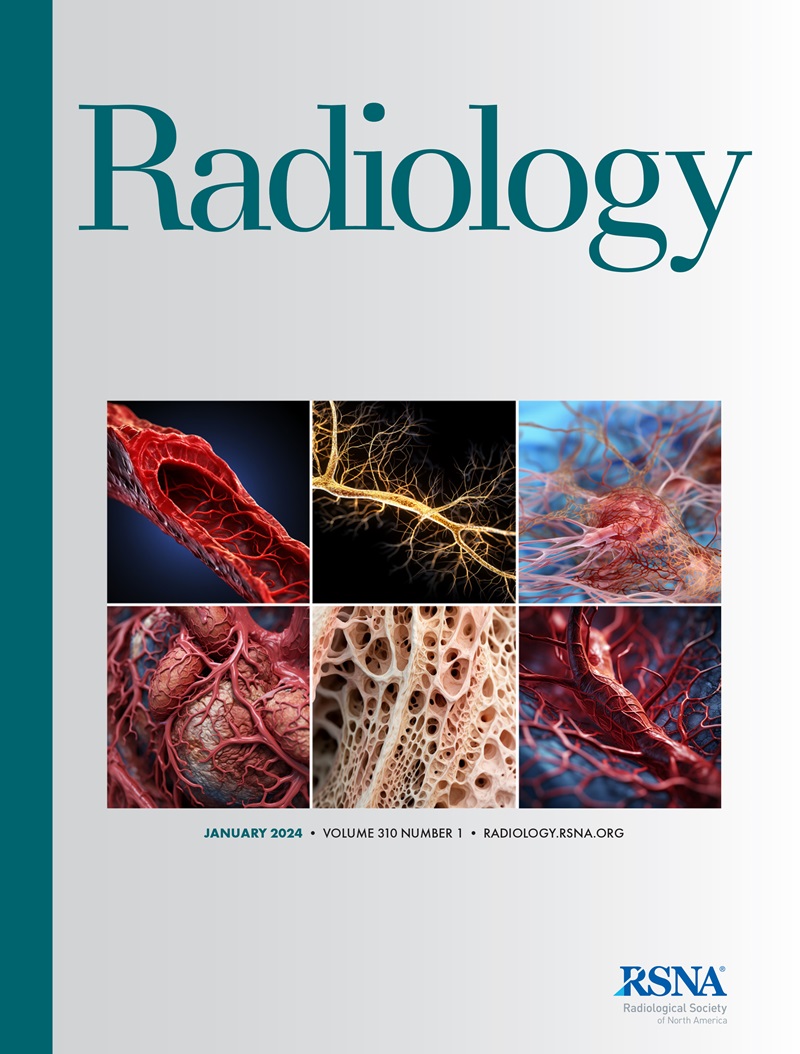求助PDF
{"title":"患者报告的症状信息对腰椎核磁共振成像解读的影响。","authors":"Rene Balza, Sarah F Mercaldo, Ambrose J Huang, Jad S Husseini, Mohamed Jarraya, F Joseph Simeone, Joao R T Vicentini, William E Palmer","doi":"10.1148/radiol.233487","DOIUrl":null,"url":null,"abstract":"<p><p>Background Distinguishing lumbar pain generators from incidental findings at MRI can be difficult. Dictated reports may become lists of findings that cannot be ranked in order of diagnostic importance. Purpose To determine whether patient-reported symptom information can improve the interpretation of lumbar spine MRI by using the spine specialist as the reference standard. Materials and Methods This prospective, single-center, multireader study analyzed 240 participants who completed pre-MRI symptom questionnaires between May 2022 and February 2023. At the time of clinical MRI reporting, radiologists recorded pain generators in consecutive participants, creating two study groups by alternating interpretations with versus without symptom questionnaire results (SQR). Diagnostic certainty was recorded using a numeric scale of 0 to 100. Types, levels, and sides of pain generators were compared with reference diagnoses by calculating Cohen κ values with 95% CIs. Participant characteristics and diagnostic certainties were compared using the Wilcoxon rank sum, Pearson χ<sup>2</sup>, or Kruskal-Wallis test. Interrater agreement was analyzed. Results There was no difference in age (<i>P</i> = .69) or sex (<i>P</i> = .60) between participants using SQR (<i>n</i> = 120; mean age, 61.0 years; 62 female) and not using SQR (<i>n</i> = 120; mean age, 62.5 years; 67 female). When radiologists were compared with specialists, agreements on pain generators were almost perfect for interpretations using SQR (type: κ = 0.82 [95% CI: 0.74,0.89]; level: κ = 0.88 [95% CI: 0.80, 0.95]; side: κ = 0.84 [95% CI: 0.75, 0.92]), but only fair to moderate for interpretations not using SQR (type: κ = 0.26 [95% CI: 0.15, 0.36]; level: κ = 0.51 [95% CI: 0.39, 0.63]; side: κ = 0.30 [95% CI: 0.18, 0.42]) (all <i>P</i> < .001). Diagnostic certainty was higher for MRI interpretations using SQR (mean, 80.4 ± 14.9 [SD]) than MRI interpretations not using SQR (60.5 ± 17.7) (<i>P</i> < .001). Interrater agreements were substantial (κ = 0.65-0.78) for MRI interpretations using SQR but only fair to moderate (κ = 0.24-0.49) for MRI interpretations not using SQR (all <i>P</i> < .001). Conclusion Patient-reported symptom information enabled radiologists to achieve nearly perfect diagnostic agreement with clinical experts. © RSNA, 2024 See also the editorial by Isikbay and Shah in this issue.</p>","PeriodicalId":20896,"journal":{"name":"Radiology","volume":"313 1","pages":"e233487"},"PeriodicalIF":12.1000,"publicationDate":"2024-10-01","publicationTypes":"Journal Article","fieldsOfStudy":null,"isOpenAccess":false,"openAccessPdf":"","citationCount":"0","resultStr":"{\"title\":\"Impact of Patient-reported Symptom Information on the Interpretation of MRI of the Lumbar Spine.\",\"authors\":\"Rene Balza, Sarah F Mercaldo, Ambrose J Huang, Jad S Husseini, Mohamed Jarraya, F Joseph Simeone, Joao R T Vicentini, William E Palmer\",\"doi\":\"10.1148/radiol.233487\",\"DOIUrl\":null,\"url\":null,\"abstract\":\"<p><p>Background Distinguishing lumbar pain generators from incidental findings at MRI can be difficult. Dictated reports may become lists of findings that cannot be ranked in order of diagnostic importance. Purpose To determine whether patient-reported symptom information can improve the interpretation of lumbar spine MRI by using the spine specialist as the reference standard. Materials and Methods This prospective, single-center, multireader study analyzed 240 participants who completed pre-MRI symptom questionnaires between May 2022 and February 2023. At the time of clinical MRI reporting, radiologists recorded pain generators in consecutive participants, creating two study groups by alternating interpretations with versus without symptom questionnaire results (SQR). Diagnostic certainty was recorded using a numeric scale of 0 to 100. Types, levels, and sides of pain generators were compared with reference diagnoses by calculating Cohen κ values with 95% CIs. Participant characteristics and diagnostic certainties were compared using the Wilcoxon rank sum, Pearson χ<sup>2</sup>, or Kruskal-Wallis test. Interrater agreement was analyzed. Results There was no difference in age (<i>P</i> = .69) or sex (<i>P</i> = .60) between participants using SQR (<i>n</i> = 120; mean age, 61.0 years; 62 female) and not using SQR (<i>n</i> = 120; mean age, 62.5 years; 67 female). When radiologists were compared with specialists, agreements on pain generators were almost perfect for interpretations using SQR (type: κ = 0.82 [95% CI: 0.74,0.89]; level: κ = 0.88 [95% CI: 0.80, 0.95]; side: κ = 0.84 [95% CI: 0.75, 0.92]), but only fair to moderate for interpretations not using SQR (type: κ = 0.26 [95% CI: 0.15, 0.36]; level: κ = 0.51 [95% CI: 0.39, 0.63]; side: κ = 0.30 [95% CI: 0.18, 0.42]) (all <i>P</i> < .001). Diagnostic certainty was higher for MRI interpretations using SQR (mean, 80.4 ± 14.9 [SD]) than MRI interpretations not using SQR (60.5 ± 17.7) (<i>P</i> < .001). Interrater agreements were substantial (κ = 0.65-0.78) for MRI interpretations using SQR but only fair to moderate (κ = 0.24-0.49) for MRI interpretations not using SQR (all <i>P</i> < .001). Conclusion Patient-reported symptom information enabled radiologists to achieve nearly perfect diagnostic agreement with clinical experts. © RSNA, 2024 See also the editorial by Isikbay and Shah in this issue.</p>\",\"PeriodicalId\":20896,\"journal\":{\"name\":\"Radiology\",\"volume\":\"313 1\",\"pages\":\"e233487\"},\"PeriodicalIF\":12.1000,\"publicationDate\":\"2024-10-01\",\"publicationTypes\":\"Journal Article\",\"fieldsOfStudy\":null,\"isOpenAccess\":false,\"openAccessPdf\":\"\",\"citationCount\":\"0\",\"resultStr\":null,\"platform\":\"Semanticscholar\",\"paperid\":null,\"PeriodicalName\":\"Radiology\",\"FirstCategoryId\":\"3\",\"ListUrlMain\":\"https://doi.org/10.1148/radiol.233487\",\"RegionNum\":1,\"RegionCategory\":\"医学\",\"ArticlePicture\":[],\"TitleCN\":null,\"AbstractTextCN\":null,\"PMCID\":null,\"EPubDate\":\"\",\"PubModel\":\"\",\"JCR\":\"Q1\",\"JCRName\":\"RADIOLOGY, NUCLEAR MEDICINE & MEDICAL IMAGING\",\"Score\":null,\"Total\":0}","platform":"Semanticscholar","paperid":null,"PeriodicalName":"Radiology","FirstCategoryId":"3","ListUrlMain":"https://doi.org/10.1148/radiol.233487","RegionNum":1,"RegionCategory":"医学","ArticlePicture":[],"TitleCN":null,"AbstractTextCN":null,"PMCID":null,"EPubDate":"","PubModel":"","JCR":"Q1","JCRName":"RADIOLOGY, NUCLEAR MEDICINE & MEDICAL IMAGING","Score":null,"Total":0}
引用次数: 0
引用
批量引用


